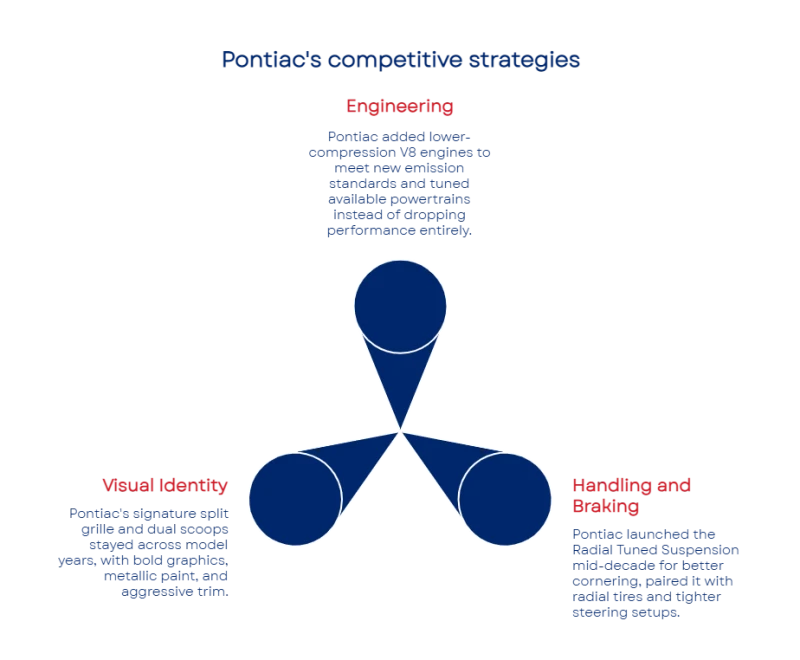By the early 1970s, Pontiac was still a dominant force in the American auto scene. Even as fuel prices climbed and regulations tightened, Pontiac found ways to build cars that were stylish, aggressive, and fast. 1970s Pontiac cars were stylish and powerful — that’s what made them memorable.
During the decade, new rules about emissions and safety forced all manufacturers, including General Motors, to make big changes. Performance declined across the board, but Pontiac didn’t give up. Instead, it adapted. Pontiac tuned engines, refined handling, and gave buyers the kind of visual impact they wanted, even when raw horsepower wasn’t as high as before.
This post explains what made Pontiac stand out in the 1970s. You’ll see how the Firebird, GTO Judge, Grand Prix, and other Pontiac models responded to change while keeping their edge. The article also highlights which models matter most today, what makes them collectible, and how you can protect their value if you own one.
What You'll Learn
Which Pontiac models defined the 1970s, like the GTO Judge, Firebird, Grand Am, and Ventura
How these muscle cars performed under stricter emissions and safety regulations
How to protect the value of classic Pontiac cars through transport, storage, and maintenance
Overview
Pontiac cars from the 1970s were notable for their blend of style and performance, adapting to changing regulations while maintaining a distinct identity. Understanding which models were most significant or collectible depends on individual preferences for features like power, aesthetics, or rarity.
Here's a more detailed breakdown:
Key Models of the 1970s
1970 Pontiac GTO & GTO Judge: These models represented the height of classic muscle car design with powerful engines and bold styling.
1971–1973 Firebird & Trans Am: These cars, especially the Trans Am Super Duty 455, maintained strong performance despite regulatory changes and became iconic.
1973 Pontiac Can Am: A rare and powerful model with a racing-inspired design that was produced for a short time
Pontiac Grand Prix (Early to Mid-1970s): This model blended luxury and muscle car features, offering both comfort and a range of V8 engine options.
Pontiac Grand Am: Introduced as a sporty mid-size car, it aimed to provide European-style handling and performance.
Pontiac LeMans & Catalina: These models served as versatile family cars or potential bases for mild performance upgrades.
Late-Decade Special Editions (1976–1979): Cars like the Firebird Trans Am focused on visual impact and unique trim packages as power decreased.
Engineering Adaptations
V8 Engines: Available across various models, these engines were tuned and adjusted to meet emissions standards while retaining performance.
Transmission Choices: Options like automatic, three-speed manual, and four-speed manual provided varying levels of control and driving feel.
Handling Improvements: Upgrades like the Radial Tuned Suspension (RTS) and variable ratio power steering enhanced cornering and ride quality.
Braking Systems: Updates to disc brakes improved stopping power, especially in performance models.
Design and Branding
Distinct Visual Identity: Pontiac maintained signature styling cues like split grilles and scooped hoods, along with bold graphics and trim.
Trim Packages and Special Editions: These additions allowed for unique aesthetics and kept models feeling fresh throughout the decade.
Pontiac’s Strategy in the 1970s
The decade brought big changes across the auto industry. Emissions rules, insurance hikes, and safety laws made it harder to build powerful cars. But Pontiac continued to focus on performance by adjusting its strategy and not giving up on its muscle car roots.
Even as a part of General Motors, Pontiac took a different approach than Chevy, Oldsmobile, or Buick. Here’s how Pontiac remained competitive during the 1970s:
1. Engineering Around Restrictions
Added lower-compression V8 engines to meet new emissions standards
Tuned available powertrains instead of dropping performance entirely
Offered flexible drivetrain choices:
Automatic transmission
Three-speed manual transmission
Four-speed manual transmission
2. Improved Handling and Braking
Launched the Radial Tuned Suspension mid-decade for better cornering.
Paired it with radial tires and tighter steering setups
Models often included:
Variable ratio power steering
Disc brakes for reliable stopping
Optional Hurst shifter and bucket seats for driver feel
3. Strong Visual Identity
Signature split grille and dual scoops stayed across model years
Bold graphics, metallic paint, and aggressive trim made cars look fast, even when power dropped.
Kept sporty packages alive on models like the Firebird, Grand Am, and GTO Judge
This combination helped Pontiac remain one of the most distinct brands of the decade. Even with the loss of raw horsepower, Pontiac delivered cars with style, balance, and a sense of speed.
Key Pontiac Models of the 1970s
The 1970s tested every automaker, but Pontiac responded with bold styling, tuned suspensions, and wide engine choices. Despite limits on emissions and compression, Pontiac models continued to deliver excitement. These standout cars carried the brand through the decade and became cornerstones of today’s classic car market.
1970 Pontiac GTO & GTO Judge
The GTO Judge symbolized everything people loved about muscle cars, exhibiting raw power, loud graphics, and a street-ready stance. It entered the decade with strength, offering high-output V8 engines and bold design.
Ram Air III and IV options delivered up to 370 hp
Equipped with a Hurst shifter, a four-speed manual transmission, and disc brakes
The GTO Judge trim added wild decals, spoilers, and standout paint
A true icon in Pontiac’s model year lineup before production ended in 1971
The GTO remained one of the best-selling Pontiac cars in early 1970s showrooms
1971–1973 Firebird & Trans Am
The second-generation Firebird evolved into a flagship for the brand. The Trans Am Super Duty 455 gave the model its lasting legacy. This car delivered real performance, even as other brands pulled back.
Super Duty V8 rated at 290 net hp, with heavy-duty internal parts
Featured RTS variable ratio power steering, and bucket seats
Trans Am styling added impact: shaker hood, fender flares, and rear spoiler
One of the few Pontiac models to maintain a strong muscle car identity throughout the decade
1973 Pontiac Can Am
Rare, aggressive, and short-lived, the 1973 Can Am was based on the LeMans, but stood apart. It offered big-block power and a bold racing theme at a time when most performance cars were fading.
Built with a 455 standard engine and sport-tuned suspension
Less than 1,400 units made during the short production window
Included special rear spoiler, racing stripe package, and unique exhaust
A rare gem in Pontiac’s muscle car history
Pontiac Grand Prix (Early to Mid-1970s)
The Grand Prix was the brand’s bridge between luxury and muscle. Pontiac gave this personal coupe a long nose, short deck, and plenty of curb appeal. Even buyers uninterested in high horsepower liked its comfort.
Offered a range of automatic transmission V8s from base to 455
Optional upgrades included power accessories and sport interiors
High-volume sales helped Pontiac stay visible in a shrinking muscle car market
Key model for Pontiac’s success during the mid-1970s
Pontiac Grand Am
Introduced in 1973, the Grand Am brought a sporty driving feel to a mid-size platform. Pontiac marketed it as an American alternative to European sports sedans. It offered strong engines, responsive handling, and clean design.
Launched with both manual and automatic transmissions
Optional four-speed manual gave it enthusiast appeal
Shared DNA with the LeMans, but had tighter steering and performance tuning
Became one of Pontiac’s most adaptable models of the decade
Pontiac LeMans & Catalina
The LeMans and Catalina weren’t the fastest, but they played an essential role in Pontiac’s lineup. Both were large enough for families but flexible enough to serve as daily drivers or mild muscle builds.
LeMans underpinned several special-edition models, including the Can Am
Catalina offered both style and space, common in used car sales lots through the 1980s
Both models featured available V8s, three-speed manual transmission, and big body styling
Kept the brand competitive in a changing landscape
Late-Decade Special Editions (1976–1979)
As power numbers dropped, Pontiac leaned harder into styling. The Firebird Trans Am became a cultural symbol known for its bold looks and unique trims. These cars kept the brand alive through the end of the decade.
Featured SE models with black-and-gold color schemes
Offered radial tires, flashy graphics, and matching interiors
These late-1970s Pontiac models focused more on styling than raw performance
Still among the most recognizable and collected Pontiac cars today
Performance and Engineering Focus
Pontiac didn’t abandon performance during the 1970s; it adapted. While emissions laws and insurance costs changed how cars were built, Pontiac continued offering strong engines, flexible transmissions, and better handling across many of its models.
V8 engines remained available across key Pontiac models like the GTO Judge, Firebird, Grand Prix, Grand Am, and Catalina.
The Super Duty 455 delivered up to 290 net horsepower with forged parts and a reinforced block.
Even base models offered solid torque for daily use, especially in mid-size and full-size cars.
Transmission choices stayed flexible, giving buyers control over how they wanted their car to drive.
Most models offered automatic transmission, three-speed manual transmission, or four-speed manual transmission.
Enthusiasts favored the four-speed manual paired with a Hurst shifter for quicker shifts and more control.
Handling improved through mid-decade upgrades that kept Pontiac competitive in a changing market.
RTS worked with radial tires to deliver tighter cornering and a smoother ride.
Some models came with variable ratio power steering, which made turns easier at low speeds and steadier on the highway.
Braking systems were updated to match the performance feel.
Disc brakes became standard on more performance models, especially the GTO and Firebird.
Full-size cars like the Grand Ville and Catalina used disc front and drum rear setups for better balance.
These engineering updates helped Pontiac continue building muscle cars that felt strong and capable, even as horsepower ratings declined.
Design, Identity, and Branding
Pontiac stood out in the 1970s for keeping a strong brand identity. While other companies softened their styling, Pontiac stayed bold. Split grilles, scooped hoods, and dramatic decals helped models like the Firebird and GTO Judge stand apart. Even full-size options like the Catalina and Grand Ville carried distinct design cues that made them feel sporty without losing their comfort.
The brand leaned into its muscle car image with trim packages, graphics, and special editions that made each model year feel fresh. From the gold-on-black Trans Am SE to the clean lines of the Grand Am, Pontiac used appearance to keep drivers excited. Across the lineup, visual impact mattered as much as performance, and it worked.
Final Thoughts
Pontiac’s legacy in the 1970s is more than just horsepower. It’s about how the brand adapted, stood its ground, and delivered vehicles that balanced performance, comfort, and unmistakable style. From the aggressive stance of the GTO Judge to the sleek lines of the Firebird Trans Am, these cars reflected a bold era that refused to be silenced by shifting regulations.
Even as emissions rules tightened and insurance costs soared, Pontiac kept building cars that turned heads and excited drivers. Today, these models still command attention from collectors and enthusiasts. Whether owned or admired, understanding their history, engineering, and cultural impact helps preserve their value.
Protecting and Transporting Your Classic Pontiac with AmeriFreight Car Shipping
If you own a classic Pontiac or plan to buy one soon, keeping it in top condition requires more than regular care. These cars are aging, and their value depends on how well they are maintained and transported. Proper transport is just as important as storage or restoration.
AmeriFreight Car Shipping provides secure transport for classic vehicles like 1970s Pontiac cars. With enclosed carriers and top-load service options, your Firebird or GTO Judge gets the protection it deserves. Learn more about our classic car shipping services and the process of transporting your classic car.
Frequently Asked Questions (FAQs)
What was the most powerful muscle car in the 1970s?
The 1970 Plymouth HEMI ‘Cuda, with a 426 HEMI V8 rated at 425 horsepower, was among the most powerful muscle cars of the decade.
What were Pontiac models in 1970?
Pontiac's 1970 lineup included the GTO, Firebird, LeMans, Grand Prix, Catalina, Bonneville, and Tempest.
What was Pontiac's muscle car?
The Pontiac GTO was its most famous muscle car, often credited with starting the muscle car era in the 1960s and continuing strong into the 1970s.
What was the fastest Pontiac?
The 1973 Firebird Trans Am Super Duty 455 was one of the fastest, capable of 0–60 mph in under six seconds.





















